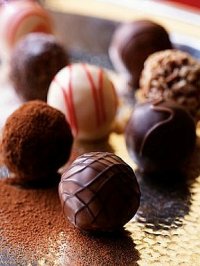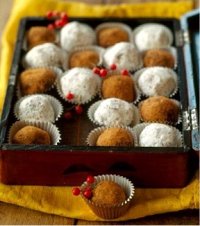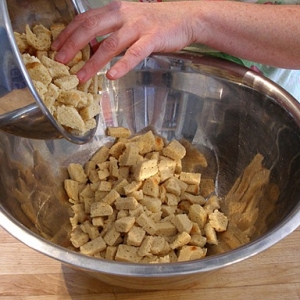Chocolate - Temper or Tempering Techniques
Copyright © 2000 Sarah Phillips CraftyBaking.com All rights reserved.
 TEMPERING CHOCOLATE is a technique by which pure or "real" chocolate is stabilized through a carefully controlled melting and cooling process, allowing the cocoa butter molecules to solidify in an orderly fashion and for the chocolate to harden properly. (More about the science of chocolate tempering.) This is not to be confused when tempering melted chocolate so it can be added as a baking ingredient to a baking recipe without it seizing or curdling the batter.
TEMPERING CHOCOLATE is a technique by which pure or "real" chocolate is stabilized through a carefully controlled melting and cooling process, allowing the cocoa butter molecules to solidify in an orderly fashion and for the chocolate to harden properly. (More about the science of chocolate tempering.) This is not to be confused when tempering melted chocolate so it can be added as a baking ingredient to a baking recipe without it seizing or curdling the batter.
Pure chocolate has no extra added ingredients beyond what is used to make up its composition - to be considered “real” chocolate, a chocolate bar or chunk can contain only cocoa butter, not any other fat - and it usually comes in large blocks. Cocoa butter is the reason why you have to “temper” real chocolate. Baking chocolate, which comes in small squares by the ounce, is not considered pure chocolate because it many times contains other ingredients, and cannot be tempered.
Commercially available pure chocolate that you buy is already tempered, but this condition changes the minute you melt it for your own use; the molecules of fat separate (as cream separates from milk). In order to put them back together, you must temper it. There are several techniques, but I have outlined what I call the "Three Step Tempering Process", explained below, which I find to be the easiest.
 Tempering is important because it determines the final gloss, hardness and contraction of chocolate, as well as improving its mouthfeel. Tempering isn't necessary for all recipes (See: Melt or Temper?), but rather depends upon what you are making. Sometimes just melting chocolate is all that's necessary. But, tempering is done when the chocolate will be used for candy making, such as molded chocolates or dipped or enrobed centers, as well as for making free-form designs or more extensive decorations, such as sculpted ones or ribbons. If you do, the chocolate will harden faster and will be glossy and holds its shape when it sets. It will also have a "snap" to it when broken or eaten, won't melt on your fingers as easily and holds its shape when stored at room temperature. Properly tempered chocolate is also great for molding candies because the candies will release out of the molds more easily - it's because it shrinks slightly at it sets.
Tempering is important because it determines the final gloss, hardness and contraction of chocolate, as well as improving its mouthfeel. Tempering isn't necessary for all recipes (See: Melt or Temper?), but rather depends upon what you are making. Sometimes just melting chocolate is all that's necessary. But, tempering is done when the chocolate will be used for candy making, such as molded chocolates or dipped or enrobed centers, as well as for making free-form designs or more extensive decorations, such as sculpted ones or ribbons. If you do, the chocolate will harden faster and will be glossy and holds its shape when it sets. It will also have a "snap" to it when broken or eaten, won't melt on your fingers as easily and holds its shape when stored at room temperature. Properly tempered chocolate is also great for molding candies because the candies will release out of the molds more easily - it's because it shrinks slightly at it sets.
If you wish to avoid tempering for dipping chocolate, you can melt candy melts, chocolate chips or just plain chocolate. But, it isn't a guarantee that it will harden with the same good qualities that tempered pure chocolate does. Chocolate chips are often used in some recipes, and melted with added cream or shortening. Candy melts, a much used chocolate-flavored product, does not need to be tempered and will fully harden. It is easier to work with, but falls short of genuine chocolate in terms of taste and texture. And, untempered chocolate dries very slowly at room temperature, is tacky to the touch, has a cakey texture when eaten, can be blotchy in appearance. It also tends to stick to its mold more readily. But, you can store items dipped in untempered chocolate in the refrigerator because the coolness will stratify the cocoa fat and it won't bloom. Just remove them a few minutes prior to serving.
|
HOW TO TEMPER CHOCOLATE - THE THREE STEP TEMPERING PROCESS for dark, milk and white and couverture chocolates. Not all chocolate types and brands temper the same way and require different melting, seeding and working temperatures, so if you are unsure, check with the manufacturer. At each step of the tempering process the temperature of the chocolate must be precise and uniform: even tiny variations can ruin the result. Use an accurate CHOCOLATE OR CANDY THERMOMETER; others may not have small enough increments in order to keep accurate track of the tempering temperatures. Take the chocolate from its heat source and stir gently right before taking its temperature. Place the tip of the thermometer in the center of the bowl, and hold it there, taking care not to let it touch the bottom or sides of the bowl. |







_100_100_s_c1.jpg)



